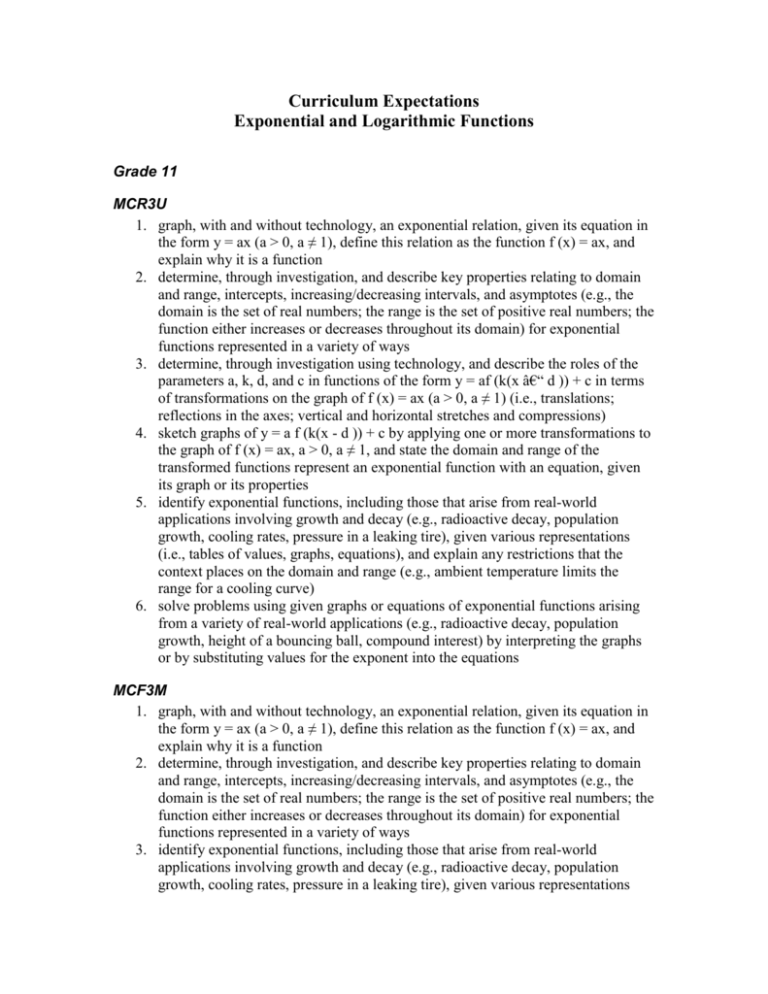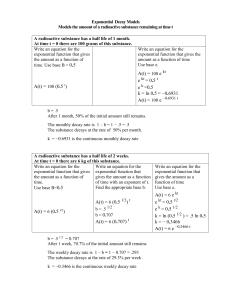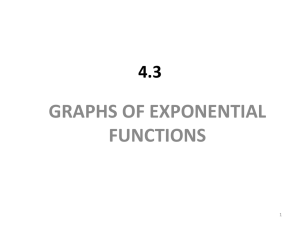Ontario Mathematics Curriculum expectations
advertisement

Curriculum Expectations Exponential and Logarithmic Functions Grade 11 MCR3U 1. graph, with and without technology, an exponential relation, given its equation in the form y = ax (a > 0, a ≠ 1), define this relation as the function f (x) = ax, and explain why it is a function 2. determine, through investigation, and describe key properties relating to domain and range, intercepts, increasing/decreasing intervals, and asymptotes (e.g., the domain is the set of real numbers; the range is the set of positive real numbers; the function either increases or decreases throughout its domain) for exponential functions represented in a variety of ways 3. determine, through investigation using technology, and describe the roles of the parameters a, k, d, and c in functions of the form y = af (k(x – d )) + c in terms of transformations on the graph of f (x) = ax (a > 0, a ≠ 1) (i.e., translations; reflections in the axes; vertical and horizontal stretches and compressions) 4. sketch graphs of y = a f (k(x - d )) + c by applying one or more transformations to the graph of f (x) = ax, a > 0, a ≠ 1, and state the domain and range of the transformed functions represent an exponential function with an equation, given its graph or its properties 5. identify exponential functions, including those that arise from real-world applications involving growth and decay (e.g., radioactive decay, population growth, cooling rates, pressure in a leaking tire), given various representations (i.e., tables of values, graphs, equations), and explain any restrictions that the context places on the domain and range (e.g., ambient temperature limits the range for a cooling curve) 6. solve problems using given graphs or equations of exponential functions arising from a variety of real-world applications (e.g., radioactive decay, population growth, height of a bouncing ball, compound interest) by interpreting the graphs or by substituting values for the exponent into the equations MCF3M 1. graph, with and without technology, an exponential relation, given its equation in the form y = ax (a > 0, a ≠ 1), define this relation as the function f (x) = ax, and explain why it is a function 2. determine, through investigation, and describe key properties relating to domain and range, intercepts, increasing/decreasing intervals, and asymptotes (e.g., the domain is the set of real numbers; the range is the set of positive real numbers; the function either increases or decreases throughout its domain) for exponential functions represented in a variety of ways 3. identify exponential functions, including those that arise from real-world applications involving growth and decay (e.g., radioactive decay, population growth, cooling rates, pressure in a leaking tire), given various representations (i.e., tables of values, graphs, equations), and explain any restrictions that the context places on the domain and range (e.g., ambient temperature limits the range for a cooling curve) 4. solve problems using given graphs or equations of exponential functions arising from a variety of real-world applications (e.g., radioactive decay, population growth, height of a bouncing ball, compound interest) by interpreting the graphs or by substituting values for the exponent into the equations MBF3C 1. determine, through investigation using a variety of tools and strategies (e.g., graphing with technology; looking for patterns in tables of values), and describe the meaning of negative exponents and of zero as an exponent 2. make and describe connections between representations of an exponential relation (i.e., numeric in a table of values; graphical; algebraic) 3. describe some characteristics of exponential relations arising from real-world applications (e.g., bacterial growth, drug absorption) by using tables of values (e.g., to show a constant ratio, or multiplicative growth or decay) and graphs (e.g., to show, with technology, that there is no maximum or minimum value) 4. pose and solve problems involving exponential relations arising from a variety of real-world applications (e.g., population growth, radioactive decay, compound interest) by using a given graph or a graph generated with technology from a given equation Grade 12 MCB4U 1. B 2.2 compare, with graphing technology, exponential and logarithmic functions using key features of graphs (e.g., domain, range, intercepts, increasing/ decreasing intervals and the occurrence of asymptotes) 2. B 2.3 determine, through investigation using technology, and describe the roles of the parameters a, k, d, and c in functions of the form y =a log 10 (k(x – d )) + c in terms of transformations on the graph of f(x) = log 10 x (i.e., translations; reflections in the axes; vertical and horizontal stretches and compressions) Aside: interactive does not use base 10 3. B 2.4 sketch graphs of y = a log 10 (k(x - d )) + c by applying one or more transformations to the graph of f(x) = log 10 x and state the domain and range of the transformed functions. Aside: interactive does not use base 10 4. B 2.5 pose and solve problems, using given graphs or equations of exponential and logarithmic functions arising from real world applications (e.g., exponential growth and decay, the Richter scale, the pH scale, the decibel scale) MAP4C 1. A 1.1 graph exponential relations using technology that model situations arising from real world applications, given their algebraic representation (e.g., h = 2(0.6)n ,where h represents the height of a bouncing ball and n represents the number of bounces) and solve problems using their graphs. a. Sample problem: The population of organisms grows exponentially under ideal conditions. Determine the number of hours it takes for the population of fruit flies to increase from 20 to 50 in your kitchen, using the graph generated with technology from the equation P = 20 (2)t/50 where P is the population at time t in hours 2. A2.5 determine, through investigation with technology (e.g., generating a table of values and graphing) and describe the changes to the graph when the initial condition or the rate of change of a linear, quadratic and exponential relation is modified (e.g., comparing simple interest and compound interest for a given principal amount). a. Sample problem: If a population triples instead of doubling, investigate and describe how the graph would change. If the initial population doubled, how would the graph change?) MCT4C 1. B 1.1 represent exponential functions in a variety of ways (e.g., tables of values, mapping diagrams, graphs, function notation, function machines) 2. Note: It has been suggested in the Proposed Revision that specific expectations B1.2 and B1.3 be removed from the MCT4C curriculum (As of November 3, 2006). 3. B 1.2 determine, through investigation using technology, and describe the roles of the parameters a, k, d, and c in functions of the form f(x) = a bk(x-d) + c in terms of transformations on the graph of f (x) = bx (b > 0, b ≠ï€ 1) (i.e., translations; reflections in the axes; vertical and horizontal stretches and compressions) 4. B 1.3 sketch graphs of f(x) = a bk(x-d) + c by applying one or more transformations to the graph of f (x) = bx, b > 0, b ≠ï€ 1, and compare the key features of the original and transformed graphs (e.g., domain and range, intercepts, increasing/decreasing intervals, and asymptotes) 5. B 2.5 pose and solve problems involving situations that can be modeled using exponential functions arising from real world applications (e.g., continuous compound interest, population growth)









